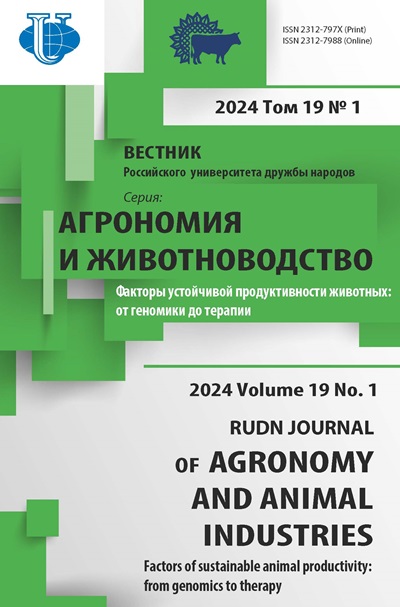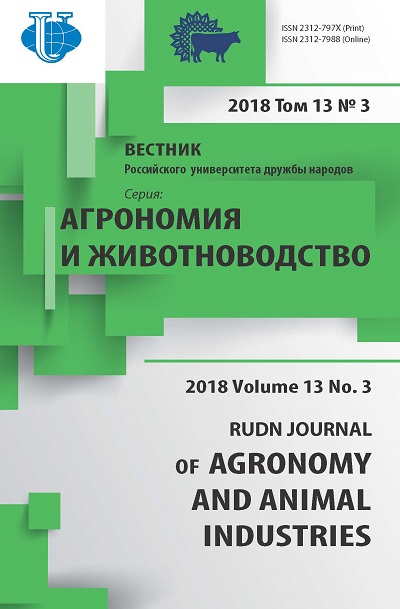WATER-SAVING IRRIGATION REGIMES FOR VEGETABLE CROP PRODUCTION UNDER CONDITIONS OF VOLGA-DON INTERFLUVE
- Authors: Akhmedov A.o.1, Dzhamaletdinova E.E.1, Zasimov A.E.1
-
Affiliations:
- Volgograd State Agricultural University
- Issue: Vol 13, No 3 (2018)
- Pages: 185-193
- Section: Agricultural technologies and land reclamation
- URL: https://agrojournal.rudn.ru/agronomy/article/view/19317
- DOI: https://doi.org/10.22363/2312-797X-2018-13-3-185-193
Cite item
Full Text
Abstract
Irrigation regimes and rates of mineral fertilizers for obtaining the expected yields of vegetable crops under conditions of light chestnut soils of the Volga-Don interfluve are considered in the study. We established that irrigation regimes and norms of mineral fertilizers proposed in our field study for table beet (Beta vulgaris) and carrot ( Daucus carota) cultivation allow yielding in the range of 60...80 t/ha. Thus, for example, the maximum yield of table beet 84.1 t/ha was obtained in the variant with 80% pre-irrigation soil moisture and N230P180K100 fertilizer at a variable depth of soil moistening (0.3...0.5 m). Changes in fertilizer dose from N130P80K20 to N230P180K100 contributed to 63.7...84.1 t/ha yield increase, which is 10-20% higher compared to other variants. Change in soil moisture from 70-80-70 to 80-80-80% of FMC in combination with fertilizer dose from N150P70K180 to N210P100K260 increased carrot yields from an average of 57.9 to 81.6 t/ha. The highest yields (81.6 t/ha) were obtained when maintaining pre-irrigation soil moisture of 80-80-80% of FMC and applying N210P100K260 fertilizer rate. In general, beet and carrot cultivation on light chestnut soils using drip irrigation is the most efficient. To maintain water regimes of the soil adopted by the experiment, a different irrigation frequency was required. When increasing humidity level from 70 to 90% FMC frequency of irrigation increases, and irrigation rate decreases. The total consumption of moisture in the experiments increased with an increase in moisture content - from 4,417 m3/ha in the variant with 70% of FMC to 5105 m3/ha in the variant with 90% of FMC. The largest total water consumption of table beet was noted in the variant with a differentiated depth of soil wetting and averaged 4,530-5,105 m3/ha. The share of irrigation water in the total water consumption of plants increased from 73.3 to 75.7%. Application of mineral fertilizers reduces water consumption of table beet. The smallest coefficient was obtained in the second irrigation regime variant, when humidity was maintained at 80% of FMC with different wetting depth. This situation was observed in all variants of irrigation regimes and fertilizer applications. This confirms that differentiating wetting depth according to table beet growth stage makes it possible to use irrigation water more economically at all rates mineral fertilizer application.
About the authors
Askar oglu Akhmedov
Volgograd State Agricultural University
Author for correspondence.
Email: askar-5@mail.ru
professor, Doctor of Engineering Science, Volgograd State Agricultural University
Universitetskiy pr., 26, Volgograd, 400002, Russian FederationElena Eurikovna Dzhamaletdinova
Volgograd State Agricultural University
Email: lena.adi@mail.ru
PhD. student, Volgograd State Agricultural University
Universitetskiy pr., 26, Volgograd, 400002, Russian FederationAnton Evgenievich Zasimov
Volgograd State Agricultural University
Email: zasimov.anton@gmail.com
Ph.D. student, Volgograd State Agricultural University
Universitetskiy pr., 26, Volgograd, 400002, Russian FederationReferences
- Akhmedov AD, Temerev AA, Galiullina EY. Ecological aspects of drip irrigation. Problemy i perspektivy innovatsionnog orazvitiya mirovogo sel'skogo khozyaistva: materialy mezhdunarodnoi nauchno-prakticheskoi konferentsii Saratovskogo GAU. Saratov; 2010. P. 156-158. (In Russ).
- Akhmedov AD, Zasimov AE. Irrigation regime of beets in conditions of the Volga-Don interfluve. Strategicheskie orientiry innovatsionnogo razvitiya APK v sovremennykh usloviyakh: materialy mezhdunarodnoi nauchno-prakticheskoi konferentsii. Volgograd: FGBOU VO Volgogradskii GAU Publ.; 2016;3. p. 106-110. (In Russ).
- Borodychev VV, Martynova AA. Irrigation regime and mineral nutrition of carrots. Melioratsiya i vodnoe khozyaistvo. 2011;(1):39-41. (In Russ).
- Borodychev VV, Martynova AA. Management of potential carrot productivity. Izvestiya Nizhnevolzhskogo agrouniversitetskogo kompleksa: nauka i vysshee professional'noe obrazovanie. 2011;21(1):17-23. (In Russ).
- Dospekhov BA. Planirovanie polevogo opyta i statisticheskaya obrabotka ego dannykh [Planning of field experiment and statistical processing of its data]. Moscow: Kolos Publ.; 1972. 207 p. (In Russ).
- Filin VI. Spravochnaya kniga po rastenievodstvu s osnovami pro-grammirovaniya urozhaya [A reference book on plant growing with basics of harvest programming]. Volgograd: VGSKhA Publ.; 1994. 274 p. (In Russ)
- Pleshakov VN. Metodika polevogo opyta v usloviyakh orosheniya [Methodology of field experiment under irrigation]. Volgograd: VNIIOZ Publ.; 1983. 148 p. (In Russ).
- Dubenok HH, Borodychev VV, Martynova AA. Mineral nutrition is an important resource for increasing carrot productivity under drip irrigation. Dostizheniya nauki i tekhniki APK. 2010;(7):24-27. (In Russ). House “Education and Science” s.r.o.; 2014. p. 28-31. (In Russ).
- Khodyakov EA, Osinkin VV, Kovalenko IA. Optimization of irrigation regime for growing table beet and zucchini under drip irrigation in the Lower Volga region. Aplikovane vedecke novinky-2014. Materialy X mezinarodni vedecko-prakticka conference. Dil. 16 Zemdelstvi. zverolekarstvi. Praha: Publishing.
- Kuznetsova NV, Stepanova NE. Photosynthetic activity of table beet crops on irrigated light chestnut lands of the Lower Volga Region. Izvestiya Nizhnevolzhskogo agrouniversitetskogo kompleksa: nauka i vysshee professional'noe obrazovanie. 2011;(1):36-42. (In Russ).
- Nikitenko GF, editor. Opytnoe delo v polevodstve [Experimentation activity in field husbandry]. Moscow: Rossel'khozizdat Publ.; 1982. 190 p. (In Russ).
















